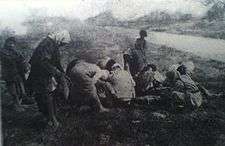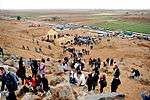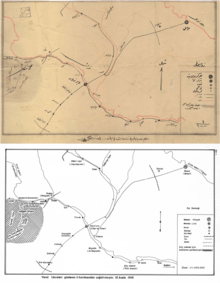Deir ez-Zor Camps
The Deir ez-Zor Camps were concentration camps[1] in the heart of the Syrian desert in which many thousands of Armenian refugees were forced into death marches during the Armenian Genocide. The United States vice-consul in Aleppo, Jesse B. Jackson, estimated that Armenian refugees, as far east as Deir ez-Zor and south of Damascus, numbered 150,000, all of whom were virtually destitute.[2]
| Deir ez-Zor Camps | |
|---|---|
| Concentration camp | |
 Armenian refugees collected near the body of a dead horse at Deir ez-Zor | |
 Location of Deir ez-Zor in contemporary Syria | |
| Coordinates | 35°20′00″N 40°9′00″E |
| Location | Deir ez-Zor, Ottoman Empire |
| Operational | 1910s |
| Inmates | Armenians |
| Killed | 150,000 |
History
Those Armenians who survived during the genocide in 1915-1916 were driven onwards in two directions: towards Damascus or along the Euphrates to Deir ez-Zor. During the early period of massacres, 30,000 Armenians were encamped in various camps outside the town of Deir ez-Zor. They were under the protection of the Arab governor, Ali Suad Bey, until the Ottoman authorities decided to replace him with Salih Zeki Bey, who was known for his cruelty and barbarity.[3][4] When the refugees, including women and children, reached Deir ez-Zor, they cooked grass, ate dead birds,[5] and although there was a cave near the Deir ez-Zor for prisoners to store until they starved, no "camp" seems ever to have been planned for the Armenians.[6]
According to Minority Rights Group,
Those who survived the long journey south were herded into huge open-air concentration camps, the grimmest of which was Deir-ez-Zor... where they were starved and killed by sadistic guards. A small number escaped through the secret protection of friendly Arabs from villages in Northern Syria.[7]
According to Christopher J. Walker, "'Deportation' was just a euphemism for mass murder. No provision was made for their journey or exile, and unless they could bribe their guards, they were forbidden in almost all cases food and water". Those who survived landed up between Jerablus and Deir ez-Zor, "a vast and horrific open-air concentration camp".[8]
Armenian Genocide
The Ottoman government persecuted the Armenian people and forced them to march out to the Syrian city of Deir al-Zour and the surrounding desert without any facilities and supplies that would have been necessary to sustain the life of hundreds of thousands of Armenian deportees during and after their forced march to the Syrian desert.[9][10]
Haj Fadel Al-Aboud, who was the mayor of Deir al-Zour, provided them with food and housing and means of livelihood and security. The Armenians returned the favor to Al-Aboud when French colonialism sentenced him to death in Aleppo; they supported and defended him, which led the French to reduce the sentence to exile in Jisr al-Shughur.[11]
Memorial

In the village of Margadeh, (88 km from Deir ez-Zor, an Armenian chapel dedicated to those massacred there during the genocide "houses some of the bones of the dead".[12] Lebanese and Syrians make pilgrimages to this memorial organized by the Armenian Apostolic Church of Aleppo.[13]
On October 20, 2008, the Australian Shadow Minister for Finance, Competition Policy and Deregulation and a member of the Australian House of Representatives Joe Hockey remarked:
Over the next [to 1915] three years, the Turkish government ordered the deportation of the remaining Armenian people in the Ottoman Empire to concentration camps in the desert between Jerablus and Deir ez-Zor. They were marched through the country on foot in a hard and cruel journey. Women and children were forced to walk over mountains and through deserts. These people were frequently stripped naked and abused. They were given insufficient food and water, and hundreds of thousands of Armenian people died along the way.[14]
Nouritza Matossian wrote for Armenian Voice:
Last month I visited the desert of Deir-ez-Zor in the killing fields, caves and rivers where a million Armenians perished. I was shown a piece of land that keeps subsiding. It is called the Place of the Armenians. So many thousands of bodies were buried there that the ground has been sinking for the last 80 years. Human thigh bones and ribs come to the surface.[15]
"For Armenians, Der Zor has come to have a meaning approximate to Auschwitz", wrote Peter Balakian in The New York Times. "Each, in different ways, an epicenter of death and a systematic process of mass-killing; each a symbolic place, an epigrammatic name on a dark map. Der Zor is a term that sticks with you, or sticks on you, like a burr or thorn: "r" "z" "or" — hard, sawing, knifelike".[16]
The memorial and museum were destroyed by ISIL in 2014.[17] The site was recaptured in 2017.[18] Syrian President Bashar al-Assad has pledged to restore the site, as part of the rebuilding of Syria.[19]
Gallery
 The Armenian Genocide museum in Deir ez Zor
The Armenian Genocide museum in Deir ez Zor The Armenian Genocide Memorial in Deir ez Zor
The Armenian Genocide Memorial in Deir ez Zor The Surp Harutyun (Holy Resurrection) Chapel of Margadeh village
The Surp Harutyun (Holy Resurrection) Chapel of Margadeh village Armenian refugee camp at Deir ez Zor
Armenian refugee camp at Deir ez Zor
See also
References
- America and the Armenian Genocide of 1915, by J. M. Winter, Cambridge University Press, 2003, p. 162
- Refugees in the Age of Total War, by Anna Bramwell, Routledge, 1988, p. 45
- Armenia: The Survival of a Nation, by Christopher J. Walker, second edition, 1990, p. 223, 229
- Kieser, Hans-Lukas (2020-04-07). Talaat Pasha: Father of Modern Turkey, Architect of Genocide. Princeton University Press. p. 263. ISBN 978-0-691-20258-7.
- A History of the Holocaust, by Saul S. Friedman, 2004, p. 330
- The First Moderns: Profiles in the Origins of Twentieth-century Thought, by William R. Everdell, University of Chicago Press, 1997, p. 124-125
- Merchants in Exile: The Armenians in Manchester, England, 1835-1935, by Joan George, Gomidas Institute, 2002, p. 164
- Armenia: The Survival of a Nation, by Christopher J. Walker, second edition, 1990, p. 210, 205
- "Exiled Armenians starve in the desert; Turks drive them like slaves, American committee hears ;- Treatment raises death rate". The New York Times. 8 August 1916. Archived from the original on 2 February 2012. (cited by McCarthy, Justin (15 August 2010). The Turk in America: The Creation of an Enduring Prejudice. University of Utah Press. p. 177. ISBN 9781607810131.)
- Danieli, Yael (1998). International Handbook of Multigenerational Legacies of Trauma. Springer Science & Business Media. p. 23. ISBN 9780306457388.
[Victims] were often held without food for days so they would be too weak to escape.
- Alshamary, Anwar, Biggest Baggara Tribe, Dar Almaref, Homs, 1996, Page: 363..
- Syria & Lebanon Handbook: The Travel Guide, by Ivan Mannheim, Footprint Travel Guides, 2001, p. 391
- "Deir ez-Zor, International Travel News, 2007". Archived from the original on 2008-12-04. Retrieved 2008-12-29.
- "Hon. Hockey's Adjournment Speech, Armenian Genocide (20 Oct 2008, House of Representatives)". Archived from the original on 1 May 2009. Retrieved 10 January 2009.
- ""Ararat" World Premier in Cannes, by [[Nouritza Matossian]]// Armenian Voice, Summer 2002, Issue 46". Archived from the original on 2005-03-17. Retrieved 2009-01-10.
- Bones, by Peter Balakian, The New York Times, December 5, 2008
- https://news.artnet.com/art-world/isis-destroys-armenian-genocide-memorial-in-syria-116406
- https://armenianweekly.com/2017/11/06/photos-der-zors-armenian-genocide-memorial-church-liberated-syrian-armed-forces/
- https://www.almasdarnews.com/article/assad-to-rebuild-armenian-genocide-memorial-church-in-deir-ezzor/
Bibliography
- To the Desert: Pages from My Diary, by Vahram Dadrian. Translated by Agop J Hacikyan, Taderon Press, 2006 ISBN 1-903656-68-0
- At the Crossroads of Der Zor: Death, Survival, and Humanitarian Resistance', by Hilmar Kaiser, Luther and Nancy Eskijian, Gomidas Institute, 2002
- Survivors: An Oral History Of The Armenian Genocide, by Donald E. Miller, Lorna Touryan Miller, University of California Press, 1999, ISBN 0-520-21956-2
External links
Documentary films
- 2011 — Grandma's Tattoos (dir. Suzanne Khardalian)